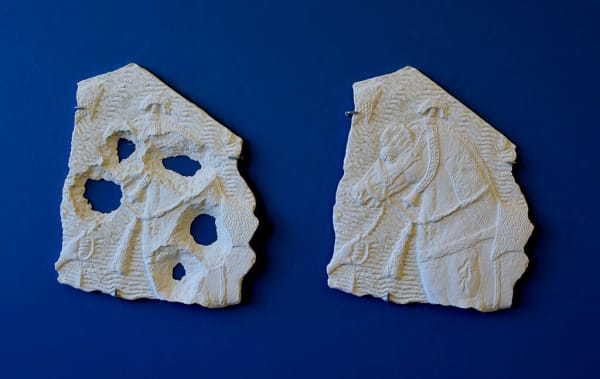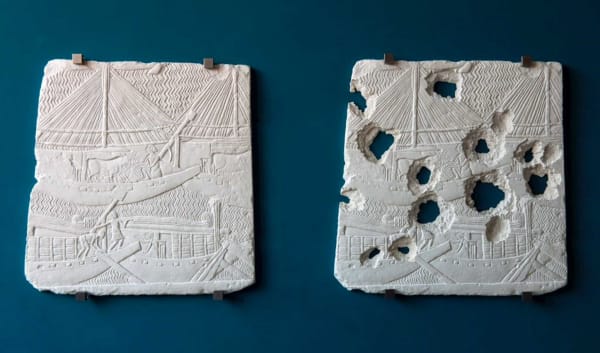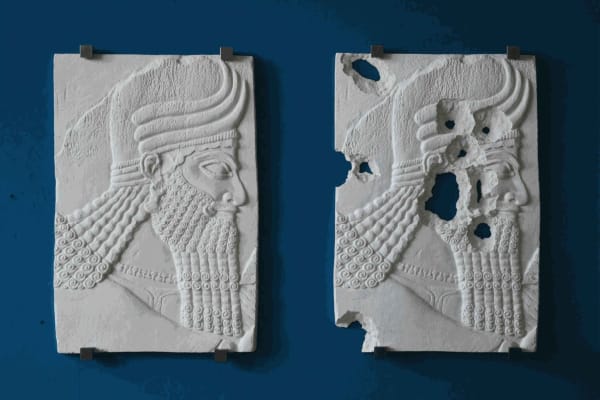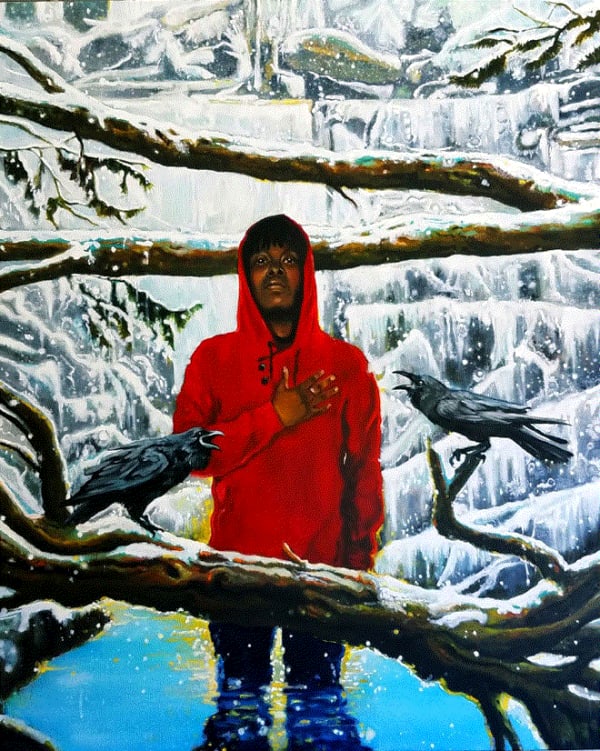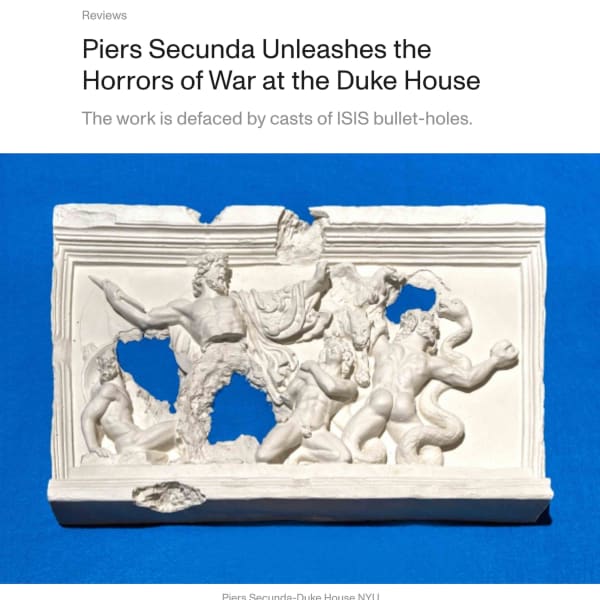Piers Secunda
-
 ISIS Bullet Hole Painting (Fours Horses), 2017
ISIS Bullet Hole Painting (Fours Horses), 2017 -
 ISIS Bullet Hole Painting (Angels), 2017
ISIS Bullet Hole Painting (Angels), 2017 -
 Assyrian Horse, 2015
Assyrian Horse, 2015 -
 ISIS Bullet Hole Painting (Assyrian Archer) , 2016
ISIS Bullet Hole Painting (Assyrian Archer) , 2016 -
 ISIS Bullet Hole Painting (Assyrian Boats), 2016
ISIS Bullet Hole Painting (Assyrian Boats), 2016 -
 ISIS Bullet Hole Painting (Temple of Zeus) , 2016
ISIS Bullet Hole Painting (Temple of Zeus) , 2016 -
 ISIS Bullet Hole Painting (Egyptians), 2017
ISIS Bullet Hole Painting (Egyptians), 2017 -
 ISIS Bullet Hole Painting (Assyrian Head), 2016
ISIS Bullet Hole Painting (Assyrian Head), 2016 -
 ISIS Bullet Hole Painting (The Wine Maker), Edition of 5. , 2016
ISIS Bullet Hole Painting (The Wine Maker), Edition of 5. , 2016 -
 911 Steel Beam Rust Drawing (Abbottabad Ancient Trees), 2021
911 Steel Beam Rust Drawing (Abbottabad Ancient Trees), 2021 -
 911 Steel Beam Rust Drawing (Root Over Rock) , 2021
911 Steel Beam Rust Drawing (Root Over Rock) , 2021
Piers Secunda explores the boundary between painting and sculpture in works that dispense with canvases and supports and address the materiality of paint. In Flag (2003), a rough-hewn, painted rectilinear form juts out from the gallery wall at a perpendicular angle, challenging the two-dimensionality of painting and altering a viewer’s experience of space. In recent years Secunda has drawn socio-political content into his forms: in 2008 he began working with crude oil, treating it as paint in works that explore humanity’s relationship to resources; for his "Taliban Relief Paintings" (2011), he travelled to Kabul, Afghanistan to cast bullet holes from scenes of suicide bombings, then incorporated these into reliefs. Describing his manipulation of paint, Secunda has said, “I cast, pour, heat, tear, smash, assemble, fuse, wrap, clamp, bolt and color it.
Piers Secunda was born in London, 1976, and lives and works in London and New York. He studied painting at Chelsea College of Art in London. Secunda has developed a studio practice using paint in a sculptural manner, rejecting the limitations imposed by the canvas. His intensive research based work, split into distinctly separate groups, explores the driving forces of both passive and aggressive human needs: examining the effects of violent geopolitics on both people and culture, by moulding bullet and bomb damage from war zones and the sites of historic conflicts, to make works. And recording energy history using crude oil as a printing medium, to examine post industrial revolution developments, both cultural and technological, which define our world today.
Secunda’s aim in life as an artist is to make records of the time in which he lives. Making a record of the violent attempts by ISIS (the Islamic State in Iraq and Syria) to erase our collective cultural heritage in the Middle East is a matter of real importance and urgency to him. For this reason he traveled to the front line of the war against ISIS in Iraq in 2015 to cast ISIS bullet holes. “Occasionally a moment occurs in which it is worth taking the risk to travel to a dangerous place. This was one such moment.” In Art Historical terms, Secunda’s work reminds of Picasso’s “Guernica” and Goya’s “Los Desastres de la Guerra” but in a Postmodern minimalist way.
Piers Secunda was born in London in 1976 and studied painting at Chelsea College of Art in London. Since the late nineties Piers has developed a studio practice using paint in a sculptural manner, rejecting the limitations imposed by the canvas.
Piers’ work has developed into a research heavy practice, which examines some of the most significant subjects of our time, such as energy and technology history and the deliberate destruction of culture.
-

First Annual Good on Paper Exhibit: Drawings and Paintings
18 Mar - 30 Apr 2022532 Gallery Good on Paper ExhibitionRead more -

Fall Breeze
6 Oct - 28 Nov 2020Chelsea, New York: 532 Gallery is pleased to present 'Fall Breeze'. Among a variation of themes and motifs, from abstract to figurative, this group exhibition presents a selection of distinct...Read more -

Ten Years After
11 Jan - 16 Feb 2018Gustavo Acosta Gustavo Acosta was born in in Havana, Cuba in 1958, and is currently based in Miami. His intensely hued portrayals of sites in Havana, Miami, New York, and...Read more -

Piers Secunda: ISIS Bullet Holes Painting
6 Apr - 6 May 2017Gathered together and displayed to potent effect at 532 Gallery, Piers Secunda’s ISIS Bullet Hole Paintings are the latest iteration of an ongoing project in which casts of bullet holes...Read more
-
Palm Beach Modern + Contemporary: Art Wynwood 2021
4 Feb - 14 Mar 2021Piers Secunda, Diana Copperwhite, Danny Rolph, Julie langsam, Ian Hughes, John Alexander Parks, Carlos Rodriguez Cardenas, Elio Roriguez, Gustavo Acosta, Jose Angel VincenchRead more -
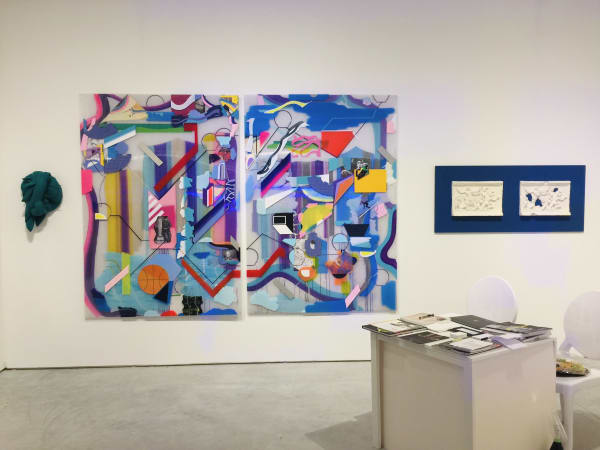
2017 CONTEXT Art Miami
5 - 10 Dec 2017Booth C117 Exhbiting Artists: Gustavo Acosta, Bernard Ammerer, Diana Copperwhite, Susana Guerrero, Ian Hughes, Nadja Verena Marcin, Julie Langsam, John Parks, Armando Marino, Elio Rodriguez,...Read more -
Art New York 2017
3 - 7 May 2017Piers Secunda, Maria Magdalena Campos-Pons, Danny Rolph, Ian Hughes, Jose Angel Vincench, Bernard AmerrerRead more -
CONTEXT Art Miami 2015
1 - 5 Dec 2015Piers Secunda, Danny Rolph, Diana Copperwhite, Julie Langsam, Ian Hughes, Elio Rodriguez, Jose Angel VincenchRead more
-

Treasures from Iraq at Oxford's Ashmolean Museum
Piers SecundaTim Hughes, Oxford Mail, December 11, 2020 -

What Remains: Creating art from destruction
Piers SecundaImperial War Museums, August 1, 2019 -

Art made from Isis bullet hole damage goes on show for first joint UK project between Iraq and Kurdistan
Piers SecundaAimee Dawson, The Art Newspaper, August 29, 2018 -

Piers Secunda Unleashes the Horrors of War at the Duke House
Piers SecundaAnthony Haden-Guest, Artnet, July 13, 2016 -

In Acts of Resistance, Artists and Scholars Digitally Reconstruct the Past
Piers SecundaClaire Voon, Hyperallergic, January 27, 2016


